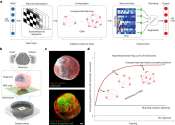Team builds the first living robots
A book is made of wood. But it is not a tree. The dead cells have been repurposed to serve another need.
Jan 13, 2020
1
591
Robotics

A book is made of wood. But it is not a tree. The dead cells have been repurposed to serve another need.
Jan 13, 2020
1
591
Hi Tech & Innovation

Clusters of lab-raised brain cells connected to a computer are capable of elementary speech recognition and math problems.
Robotics

A team of researchers at the City University of Hong Kong have found a way to use micro-robots to carry a cluster of cells to a target site in live animals. In their paper published in the journal Science Robotics, the group ...
Robotics

A team of researchers affiliated with multiple institutions in China and one in Korea has developed a micro-robot system that regenerated knee cartilage in rabbits. In their paper published in the journal Science Advances, ...
Engineering

Over the course of their lives, some humans can partly or fully lose the ability to move their limbs because of damage to their cartilage, the flexible connective tissues cushioning the bones. This can be due to degenerative ...
Robotics

In a new study published in the Proceedings of the National Academy of Sciences, researchers from University of Toronto have demonstrated a novel and non-invasive way to manipulate cells through microrobotics.
Jul 8, 2019
0
431
Engineering

Syringes and hollow needles have been used to deliver medication for more than a century. However, the precise implementation of these devices depends on the operator, and it can be difficult to deliver medication to delicate ...
Feb 25, 2019
0
111
Internet

Until very recently, if you wanted to know more about a controversial scientific topic—stem cell research, the safety of nuclear energy, climate change—you probably did a Google search. Presented with multiple sources, ...
May 24, 2023
0
37
Internet

Google said Friday it was banning online ads for unproven medical treatments including most stem cell and gene therapy.
Sep 7, 2019
0
4
Machine learning & AI

Every day, millions of single blood cells are evaluated for disease diagnostics in medical laboratories and clinics. Most of this repetitive task is still done manually by trained cytologists who inspect cells in stained ...
Nov 12, 2019
0
18
Stem cells are cells found in most, if not all, multi-cellular organisms. They are characterized by the ability to renew themselves through mitotic cell division and differentiating into a diverse range of specialized cell types. Research in the stem cell field grew out of findings by Canadian scientists Ernest A. McCulloch and James E. Till in the 1960s. The two broad types of mammalian stem cells are: embryonic stem cells that are isolated from the inner cell mass of blastocysts, and adult stem cells that are found in adult tissues. In a developing embryo, stem cells can differentiate into all of the specialized embryonic tissues. In adult organisms, stem cells and progenitor cells act as a repair system for the body, replenishing specialized cells, but also maintain the normal turnover of regenerative organs, such as blood, skin or intestinal tissues.
Stem cells can now be grown and transformed into specialized cells with characteristics consistent with cells of various tissues such as muscles or nerves through cell culture. Highly plastic adult stem cells from a variety of sources, including umbilical cord blood and bone marrow, are routinely used in medical therapies. Embryonic cell lines and autologous embryonic stem cells generated through therapeutic cloning have also been proposed as promising candidates for future therapies.
This text uses material from Wikipedia, licensed under CC BY-SA